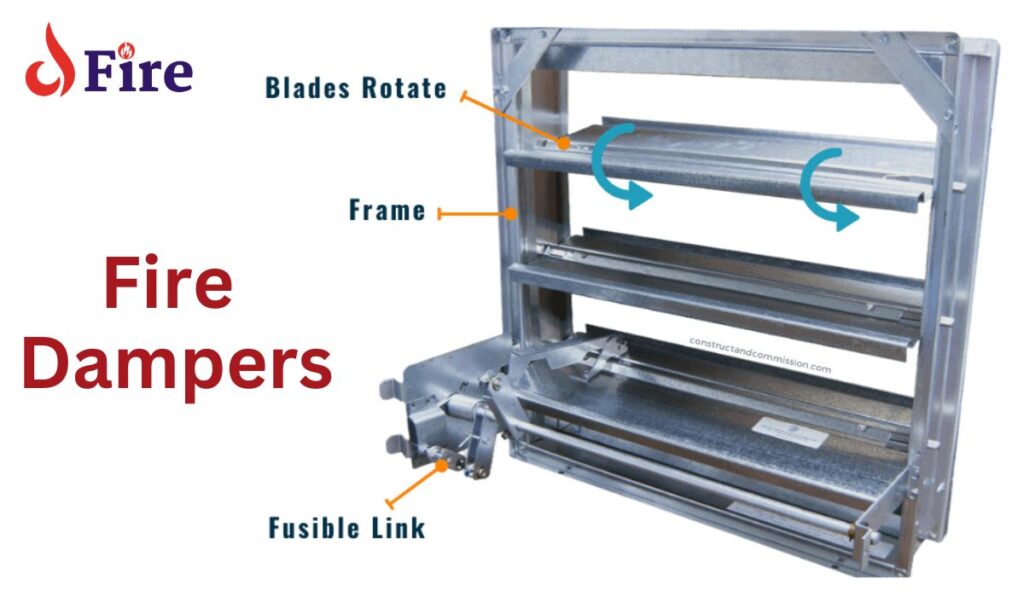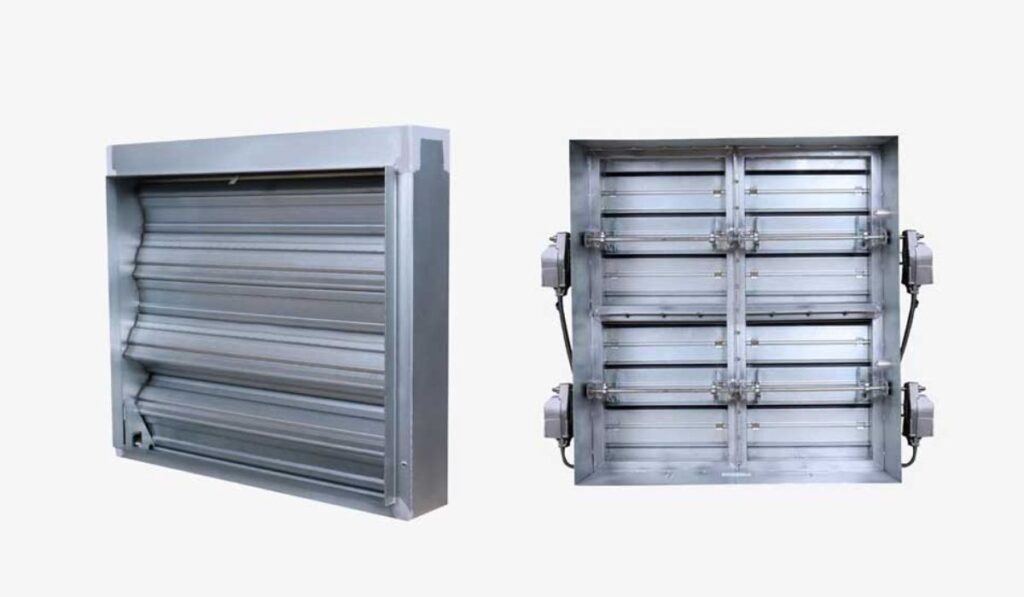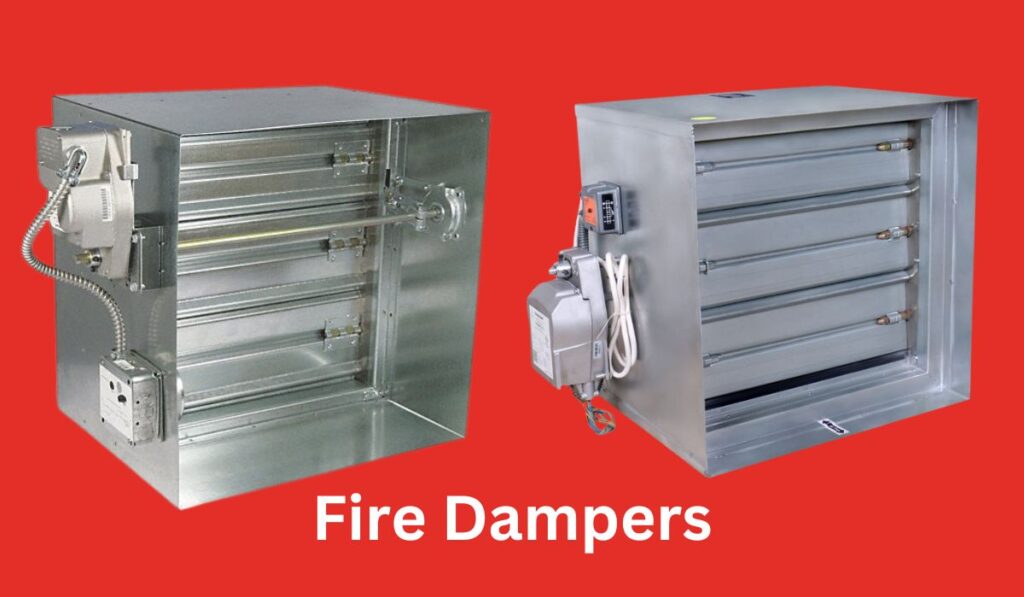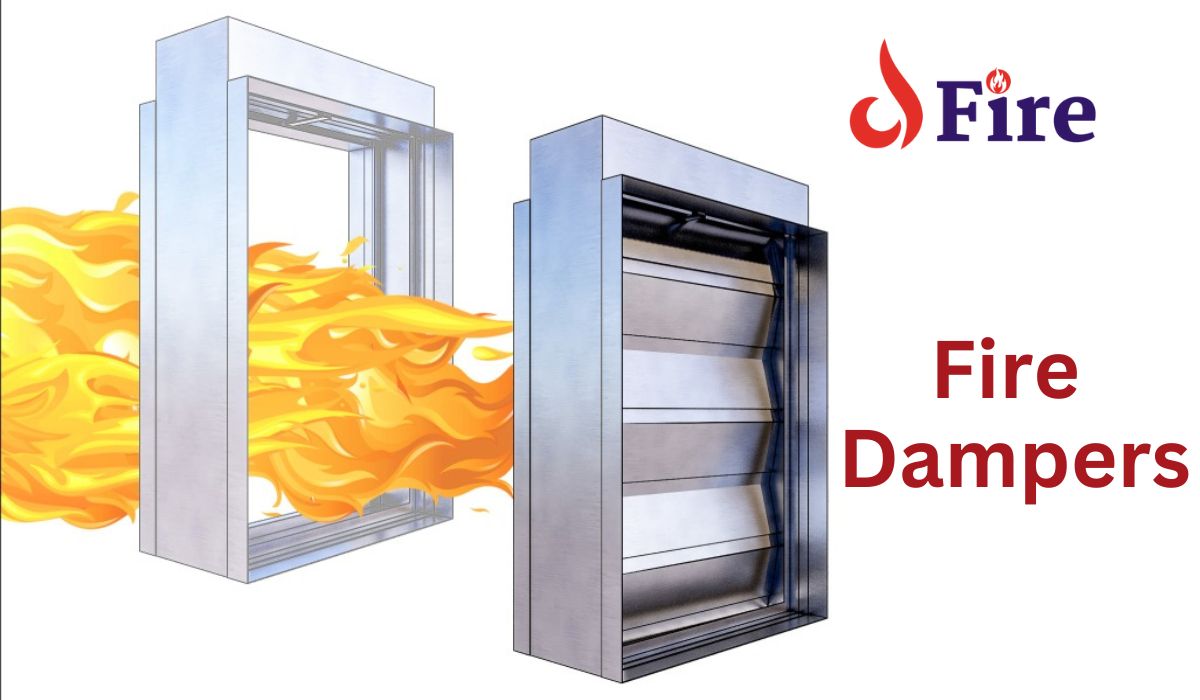Type A fire dampers are designed for use in HVAC systems to prevent the spread of flames through ductwork. These devices automatically close upon detection of heat.
Fire safety in buildings hinges on the installation of reliable fire dampers, and Type A fire dampers play a pivotal role in this protection strategy. They serve as critical components in heating, ventilation, and air conditioning systems, providing a physical barrier against fire and smoke.
Engaging in regular maintenance and inspections is essential to ensuring their proper function in an emergency. These dampers are engineered to react to a rise in temperature, sealing off the affected duct, and thereby thwarting the progress of a fire. Building codes often mandate the use of Type A fire dampers in certain areas for optimal safety. Architects, engineers, and safety inspectors must be well-acquainted with the specific requirements of these devices.
The Critical Role Of Fire Dampers

Fire dampers serve as a key defense mechanism in a building’s fire safety strategy. These devices are crucial in maintaining the integrity of a building’s fire-resistant barriers. They work quietly behind the scenes to prevent disastrous consequences during a fire outbreak. At its core, a fire damper’s job is to stop fire and smoke from spreading through a building’s ventilation system.
Preventing The Spread Of Fire And Smoke
One essential function of fire dampers is to contain fire and smoke at its source. They are typically installed within ductwork, where they remain open during normal conditions, allowing air to pass freely. In the event of a fire, the dampers close automatically. This action prevents the spread of flame and harmful smoke through the ducts, buying crucial time for evacuation and emergency response.
- Automatic closure in response to heat
- Barrier for flames and toxic smoke
- Helps to minimize damage and maintain safe escape routes
Enhancing Overall Building Safety
Fire dampers contribute significantly to a building’s overall safety structure. Their integration into the building design helps ensure compliance with fire safety codes. They not only safeguard lives but also protect the integrity of the building and its contents. Regular maintenance and testing of fire dampers are mandatory to ensure they function correctly during an emergency.
| Benefits of Fire Dampers |
|---|
| Life protection |
| Property protection |
| Compliance with safety codes |
| Requires routine maintenance |
What Exactly Are Type A Fire Dampers?

Imagine a superhero within the walls of a building, guarding against fire. That’s what Type A Fire Dampers do. They play a crucial role in fire safety systems. When a fire occurs, these dampers spring into action. They prevent the spread of fire and smoke through a building’s ventilation system.
Design And Features
Type A Fire Dampers come with a smart design. They are installed within ductwork where it passes through fire-resistant walls and floors. Their design is so clever that it can detect heat. Upon sensing a certain temperature, they activate and seal the duct. This stops fire in its tracks. Key features include:
- Heat Sensing Mechanism: An element that triggers closure upon reaching a specific temperature.
- Interlocking Blades: These blades form a tight seal when closed.
- Release Mechanism: Allows for manual testing and resetting.
Materials And Durability
Fire dampers must be tough. They are built from materials that withstand high temperatures. Most Type A Fire Dampers are made from:
| Material | Property |
|---|---|
| Galvanized Steel | Resistant to heat and corrosion |
| Stainless Steel | Extra durability and strength |
| Aluminum | Lightweight and corrosion resistant |
They are built to last many years. Their sturdy construction ensures they are a reliable part of your fire protection plan.
Comparing Fire Damper Types
Fire dampers are crucial in stopping fires in buildings. They close ducts to prevent flames from spreading. Different types exist, each with unique features. Understanding these differences helps choose the right one for any building project.
Type A Vs Type B: What’s The Difference?
Type A and Type B fire dampers stack up differently:
- Type A has a fusible link that melts at a lower temperature.
- Type A dampers can be in vertical and horizontal ducts.
- Type B needs higher temperatures to activate.
- Type B is often used in vertical ducts only.
Choosing between Type A and B hinges on duct orientation and fire risks.
Selection Criteria For Building Projects
Picking the best fire damper involves several factors:
| Factor | Description |
|---|---|
| Building Code | Match dampers to local safety rules. |
| Duct Type | Size and orientation guide the choice. |
| Fire Risk | Evaluate hazards in the area. |
| Temperature Sensitivity | Check the trigger temperature of the damper. |
Installation Tactics For Maximum Efficacy
Almost every building needs a fire safety plan. Type a Fire Dampers play a critical role. They stop fire from moving through a building’s ductwork. To work best, they must sit in the right place and the right way. Let’s dig into how to install Type a Fire Dampers for top performance.
Location And Placement Best Practices
Location is key for fire damper function. Follow building codes and manufacturer guidelines. Always choose locations easy to reach for checks and maintenance. Here’s where to start:
- Pick accessible spots for easy inspection.
- Place dampers away from bends in ductwork for clear operation.
- Ensure dampers align with wall ratings. Matching is essential.
- Use retaining angles correctly to hold dampers in place.
- Keep a min gap between damper and duct corners for secure installation.
Common Installation Challenges
Installation can be tough. Workers face many issues. Here are common ones with fixes:
| Challenge | How to Overcome |
|---|---|
| Wrong Size Openings | Double-check the duct vs damper size before setup. |
| Incorrect Hardware | Use only hardware that the damper maker says to. |
| Alignment Issues | Regularly use a level during setup to keep dampers straight. |
| Sealant Errors | Apply firestop sealants as per the fire code requirements. |
| Tight Spaces | Plan ahead. Clear the space around the damper location. |
Prepare and plan well. This is the best way to beat challenges. Get the right tools and follow steps without rushing. Doing so makes dampers work as they must in case of a fire.
Performance In Action
Imagine a building, tall and bustling. Now think of fire breaking out. Scary? Not with Type A fire dampers in place. These robust devices leap into action during fire, sealing off ductwork to stop fire and smoke from spreading. Their job is simple but life-saving – they keep flames at bay, allowing precious time for evacuation. Here’s how they perform under pressure:
Case Studies Of Type A Dampers
Real incidents show the might of Type A fire dampers. Each case study tells a story of potential disaster averted. Here are brief outlines of their success stories:
- High-Rise Havoc Prevented: A 50-story skyscraper faced a kitchen fire on the 30th floor. Type A dampers shut tight, confining the fire.
- School Saved in Seconds: A school’s heating system caught fire. The dampers activated, keeping the hallways clear of smoke.
- Hospital Held Harmless: In a healthcare facility, a utility room’s blaze was contained, ensuring patient safety, thanks to these dampers.
Real-world Impact On Fire Containment
Type A dampers don’t just work; they excel in protecting lives and property. They stand as silent guardians, ready to activate at the first sign of trouble. Their impact is measurable:
| Location | Incident | Outcome with Type A Fire Damper |
|---|---|---|
| Shopping Center | Electrical Fire | Shops safeguarded, zero spread to adjacent areas |
| Apartment Complex | Garage Fire | Residents secure, fire contained within origin zone |
| Office Building | Server Room Overheat | Crucial data protected, business operations uninterrupted |
These stories highlight Type A fire dampers in action. Facilities across the globe rely on them. They are unsung heroes in fire safety, consistently delivering on their promise to protect and preserve.

Regular Maintenance For Long-term Reliability
Fire dampers are crucial in preserving the integrity of fire-resistance rated walls and floors. Regular maintenance ensures they function correctly when needed. Without proper care, dampers may fail to operate during a fire, leading to catastrophic consequences. Keeping them in optimal condition is essential for safety.
Inspection Schedules
Routine checks are vital for the longevity of Type A fire dampers. These checks must follow local safety regulations and the manufacturer’s guidelines.
| Environment | Inspection Frequency |
|---|---|
| Hospitals | 6 Months |
| Schools | Annually |
| Industrial Buildings | Annually |
- Inspect dampers semi-annually in hospitals.
- Inspect annually in schools and industrial buildings.
- Document inspections meticulously.
Maintenance Procedures
Following the inspection, perform maintenance procedures to fix any issues. Here’s a step-by-step guide to ensure proper upkeep:
- Clean the damper and surrounding area.
- Check for signs of damage or corrosion.
- Ensure moving parts are free of blockage.
- Lubricate parts, if necessary.
- Test damper operation manually.
- Replace any faulty parts immediately.
Keeping detailed records of all actions taken is essential. The goal is to ensure immediate corrective measures are applied if a fault is detected. Always consult the manufacturer’s manual for specific maintenance instructions for Type A fire dampers.
Legal And Compliance Considerations
When installing Type A fire dampers, law and safety are key. Every building must meet strict codes. These dampers must pass safety tests. This keeps everyone safe. Let’s talk about codes and what’s needed for safety.
Building Codes And Standards
Local and national codes guide fire damper use. These codes ensure buildings stay safe. Fire dampers must meet these codes to be used.
Every area has its own rules. This can include how and where to install dampers. It’s important to know your local rules. This keeps your building legal.
The International Building Code (IBC) sets broad rules. Most places follow this or something similar. The IBC says fire dampers must close during a fire. This stops the fire from moving around.
Fire dampers also must fit the system they’re in. The dampers must be strong enough to last fires.
Your dampers need regular checks and maintenance. This makes sure they work when needed.
Certification Requirements For Safety
All fire dampers need proper certificates. These say the damper is safe and follows the rules. Without them, you can’t use the dampers.
Certificates come from tests. Labs test dampers to see if they can handle fire. Labs give a label if the damper passes. This label is proof of testing.
Look for UL or FM labels on dampers. These mean the dampers are safe. They have passed tough tests.
You need to check your dampers often. This makes sure they keep their label. It keeps the dampers ready for an emergency.

Credit: www.amazon.com
Future Innovations In Fire Damper Technology
Fire dampers play a vital role in keeping buildings safe. New technology makes them even better. Let’s explore what’s next for these devices.
Advancements In Materials
Future fire dampers will be different. They will use materials that can withstand high heat for longer periods. These materials might include:
- Composite materials: Light but very strong.
- Graphene coatings: Help resist fire and prevent corrosion.
- New alloys: Special metals that don’t melt easily.
These materials make fire dampers lighter and tougher.
Smart Detection And Response Features
Smart fire dampers are coming. These will know when to activate without waiting for smoke or heat. Key features may include:
| Feature | Function |
|---|---|
| Sensors | Detect fire signs fast. |
| Wi-Fi Connectivity | Send alerts to phones or computers. |
| Automated Systems | Close or open without human help. |
With these features, fire dampers will be quicker and smarter in emergencies.
Frequently Asked Questions On Type A Fire Dampers
What Is Type A Fire Damper?
A Type A fire damper automatically closes to prevent fire and smoke spreading through ducts in fire-rated walls and floors.
What Is Type C Fire Damper?
A Type C fire damper is designed to close during a fire, preventing the spread of flames and smoke through ductwork in heating, ventilation, and air conditioning (HVAC) systems.
What Are The Classification Of Fire Dampers?
Fire dampers are classified into static, dynamic, and combination types. Static is for HVAC systems that shut down during a fire. Dynamic dampers operate even when airflow continues. Combination dampers serve both functions.
What Is The Class Rating Of A Fire Damper?
The class rating of a fire damper indicates its fire resistance duration, commonly ranging from 1 to 4 hours as specified by UL555 standards.
Conclusion
Fire dampers play a critical role in enhancing building safety against fires. Selecting the right type ensures efficacy and compliance with safety standards. For effective fire prevention strategies, incorporating appropriate fire dampers is a must. Prioritize consulting experts to optimize your building’s fire protection systems.
Remember, the right choice saves lives and property.

I’m Abdus Sobur, a highly skilled and professional Fire Safety Officer with a passion for safeguarding lives and property. Over the course of my career, I’ve conducted numerous successful fire safety audits, earning a reputation for excellence in ensuring public safety.
In addition to my role as a Fire Safety Officer, I’m also dedicated to raising awareness about the importance of fire safety. Through my blog, I share insights into the functions of different fire safety equipment, aiming to empower individuals with the knowledge they need to protect themselves and their communities.
I’m driven by a deep commitment to promoting fire safety awareness and preventing fire-related incidents.

